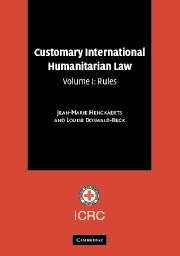Book contents
- Frontmatter
- Contents
- Foreword by ICRC President Jakob Kellenberger
- Foreword by Judge Abdul G. Koroma
- Foreword by Yves Sandoz
- Acknowledgements
- Introduction
- List of abbreviations
- Part I The Principle of Distinction
- Part II Specifically Protected Persons and Objects
- Part III Specific Methods of Warfare
- Part IV Weapons
- Chapter 20 General Principles on the Use of Weapons (Rules 70–71)
- Chapter 21 Poison (Rule 72)
- Chapter 22 Nuclear Weapons
- Chapter 23 Biological Weapons (Rule 73)
- Chapter 24 Chemical Weapons (Rules 74–76)
- Chapter 25 Expanding Bullets (Rule 77)
- Chapter 26 Exploding Bullets (Rule 78)
- Chapter 27 Weapons Primarily Injuring by Non-detectable Fragments (Rule 79)
- Chapter 28 Booby-traps (Rule 80)
- Chapter 29 Landmines (Rules 81–83)
- Chapter 30 Incendiary Weapons (Rules 84–85)
- Chapter 31 Blinding Laser Weapons (Rule 86)
- Part V Treatment of Civilians and Persons Hors De Combat
- Part VI Implementation
Chapter 26 - Exploding Bullets (Rule 78)
Published online by Cambridge University Press: 05 June 2012
- Frontmatter
- Contents
- Foreword by ICRC President Jakob Kellenberger
- Foreword by Judge Abdul G. Koroma
- Foreword by Yves Sandoz
- Acknowledgements
- Introduction
- List of abbreviations
- Part I The Principle of Distinction
- Part II Specifically Protected Persons and Objects
- Part III Specific Methods of Warfare
- Part IV Weapons
- Chapter 20 General Principles on the Use of Weapons (Rules 70–71)
- Chapter 21 Poison (Rule 72)
- Chapter 22 Nuclear Weapons
- Chapter 23 Biological Weapons (Rule 73)
- Chapter 24 Chemical Weapons (Rules 74–76)
- Chapter 25 Expanding Bullets (Rule 77)
- Chapter 26 Exploding Bullets (Rule 78)
- Chapter 27 Weapons Primarily Injuring by Non-detectable Fragments (Rule 79)
- Chapter 28 Booby-traps (Rule 80)
- Chapter 29 Landmines (Rules 81–83)
- Chapter 30 Incendiary Weapons (Rules 84–85)
- Chapter 31 Blinding Laser Weapons (Rule 86)
- Part V Treatment of Civilians and Persons Hors De Combat
- Part VI Implementation
Summary
Rule 78. The anti-personnel use of bullets which explode within the human body is prohibited.
Practice
Volume II, Chapter 26.
Summary
State practice establishes this rule as a norm of customary international law applicable in both international and non-international armed conflicts.
International armed conflicts
The prohibition of exploding bullets originated in 1868 with the adoption of the St. Petersburg Declaration, which was motivated by the desire to avoid inflicting suffering which exceeded that needed to render a combatant hors de combat. To this end, the Declaration specifically prohibits the use of “any projectile of a weight below 400 grammes, which is either explosive or charged with fulminating or inflammable substances”, 400 grams being the weight of the smallest artillery shell at the time. Nineteen States adhered to the St. Petersburg Declaration in 1868 or 1869, i.e., most of the States in existence at that time. The prohibition contained in the St. Petersburg Declaration was repeated in the Brussels Declaration, the Oxford Manual and the Oxford Manual of Naval War. The Report of the Commission on Responsibility set up after the First World War identified the use of “explosive bullets” as a war crime under customary international law.
Practice since the adoption of the St. Petersburg Declaration has modified this prohibition, as exploding anti-aircraft bullets were introduced in the First World War. Furthermore, lighter grenades and exploding anti-materiel bullets have been introduced since. These developments have occurred without any objection.
- Type
- Chapter
- Information
- Customary International Humanitarian Law , pp. 272 - 274Publisher: Cambridge University PressPrint publication year: 2005
- 1
- Cited by

